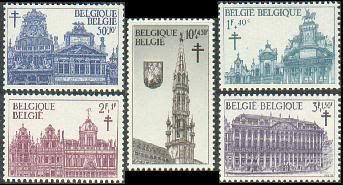I would like to swap some World Heritage duplicates I still have!
Here is my offer list.
I swap under those conditions.
1. on 1:1 basis for not to expensive stamps.
2. facial value if the stamps you offer are from the country you live in or if you bought them on facial value yourself.
3. on Michel catalogue value.
4. I can also sell them
If you are intersted in swapping with me, click on "comments". :o)
Thursday, April 17, 2008
Wantlist
I would like to swap some World Heritage stamps I still need!
Here is my want list.
I swap under those conditions.
1. on 1:1 basis for not to expensive stamps.
2. facial value if the stamps you offer are from the country you live in or if you bought them on facial value yourself.
3. on Michel catalogue value.
If you are intersted in swapping with me, click on "comments":o)
Here is my want list.
I swap under those conditions.
1. on 1:1 basis for not to expensive stamps.
2. facial value if the stamps you offer are from the country you live in or if you bought them on facial value yourself.
3. on Michel catalogue value.
If you are intersted in swapping with me, click on "comments":o)
Wednesday, April 16, 2008
Historic quarter of the city of Colonia del Sacramento
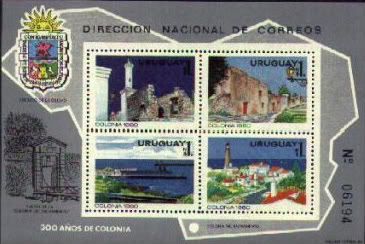

Founded by the Portuguese in 1680 on the Rio de la Plata, the city fulfilled a strategic function against the Spanish Empire. Disputed for a century, it was finally lost by its founders. Its preserved urban landscape, a mixture of solemnity and intimacy, is an example of the successful fusion of the Portuguese, Spanish and post-colonial styles.
Tuesday, April 15, 2008
Archeological Site of Monte Alban
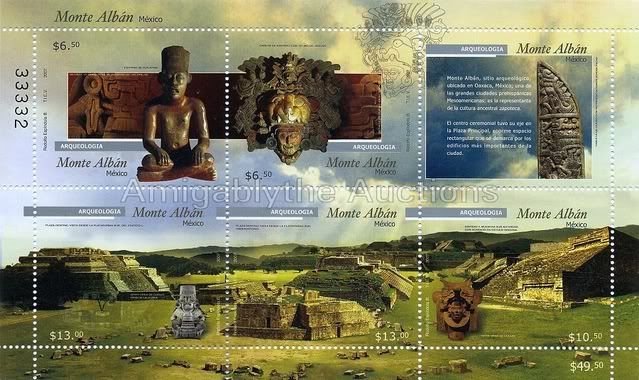
Inhabited over a period of 1500 years by a succession of peoples - Olmecs, Zapotecs and Mixtecs - the terraces, dams, canals, pyramids and artificial mounds of Monte Alban were literally carved out of the mountain and are the symbols of a sacred topography. Nearby, the checkerboard design of Oaxaca is a good example of the Spanish colonial architecture.
Monday, April 14, 2008
Rennell East

East Rennell makes up the southern third of Rennell Island, the southernmost island in the Solomon Island group in the western Pacific. Rennell, 86 km long and 15 km wide, is the largest raised coral atoll in the world. The site covers approximately 37,000 hectares plus a marine area extending three nautical miles to sea. A major feature of the island is Lake Tegano which was the former lagoon on the atoll. The lake, the largest in the insular Pacific (15,500 hectares), is brackish and contains many rugged limestone islands and endemic species. Rennell is mostly covered with dense forest with a canopy averaging 20 m in height. Combined with strong climatic effects of frequent cyclones, the site is a true natural laboratory for scientific study. The site is under customary land ownership and management.
Grand-Place at Brussels
Chongoni Rock Art Area

Situated within a cluster of forested granite hills and covering an area of 126.4 km2, high up the plateau of central Malawi, the area features the richest concentration of rock art in Central Africa on 127 sites. They reflect the comparatively scarce tradition of farmer rock art, as well as paintings by BaTwa hunter-gatherers who inhabited the area from the Late Stone Age. The Chewa agriculturalists, whose ancestors lived in the area from the late Iron Age, practised rock painting until well into the 20th century. The symbols in the rock art, which are strongly associated with women, still have cultural relevance amongst the Chewa, and the sites are actively associated with ceremonies and rituals.
Friday, April 04, 2008
White City of Tel Aviv


Tel Aviv was founded in 1909 and developed under the British Mandate in Palestine (1920-1948). The White City was constructed from the early 1930s till 1948, based on the urban plan by Sir Patrick Geddes, reflecting modern organic planning principles. The buildings were designed by architects who were trained in Europe where they practiced their profession before emigrating to Palestine. They created an outstanding architectural ensemble of the modern movement in a new cultural context.
Massada National Park

The site of the self-immolation of approximately a thousand Jewish patriots in the face of a large Roman army, Massada is a symbol of the ancient kingdom of Israel. Built as a palace complex and place of refuge by Herod the Great, King of Judaea (reigned 37–4 bc), Masada’s extensive remains survive on the summit of this seemingly impregnable fortress, set in a rugged natural landscape of great beauty. The siege works of the Roman army and other related sites lie unexcavated at the base of the rock.
Old City of Acre

The historic townscape of the walled port city of Acre is characteristic of Islamic town planning, with narrow winding streets and fine public buildings and houses. Beneath the 18th and 19th century Ottoman Acre, lie almost intact the remains of its predecessor, the Crusader city, dating from 1104 to 1291. Crusader Acre is today mostly subterranean and has only recently begun to be revealed.
National Archaeological Park of Tierradentro and San Agustin archeological Park

National Archaeological Park of Tierradentro
The park includes monumental statues of human figures and contains many hypogea dating from the 6th to 10th centuries. These huge underground tombs (some death chambers are up to 12 m wide) are decorated with motifs that reproduce the internal decor of homes of the period. They bear witness to the social complexity and cultural wealth of a pre- Hispanic society in the northern Andes.
San Agustín archeological Park
In a wild, spectacular landscape stands the largest group of religious monuments and megalithic sculptures in South America. Gods and mythical animals are skilfully represented in styles ranging from abstraction to realism. These works of art display the creativity and imagination of a north Andean culture that flourished from the 1st to the 8th century.
Wednesday, April 02, 2008
Shirakami-Sanchi

This SS was issued by Palau in 1997 on the occasion of the 50th Anniversary of UNESCO, depicting the Forest of Shirakami-Sanchi, Japan.
Situated in the mountains of northern Honshu, this trackless site includes the last virgin remains of the cool-temperate forest of Siebold's beech trees that once covered the hills and mountain slopes of northern Japan. The black bear, the serow and eighty-seven species of birds can be found in this forest.
Yakushima
Also from Palau issued in 1997 on the 50th anniversary of UNESCO.
Located in the interior of Yaku Island, at the meeting point of the palearctic and oriental biotic regions, Yakushima exhibits a very rich flora, with some 1,900 species and subspecies, including ancient specimens of the sugi (Japanese cedar). It also contains a remnant of a warm-temperate ancient forest, unique in the region.
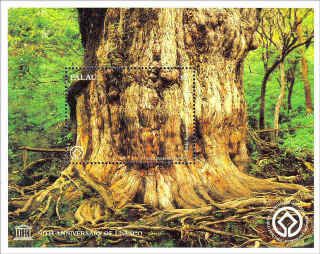
Located in the interior of Yaku Island, at the meeting point of the palearctic and oriental biotic regions, Yakushima exhibits a very rich flora, with some 1,900 species and subspecies, including ancient specimens of the sugi (Japanese cedar). It also contains a remnant of a warm-temperate ancient forest, unique in the region.

Honduras – Maya site of Copán
This set has one SS and 3 stamps issued in 1978 but I have only two SS. You can see one SS in this post and another SS is the overprint issue.
Discovered in 1570 by Diego García de Palacio, the ruins of Copán, one of the most important sites of Mayan civilization, were not excavated until the 19th century. Its citadel and imposing public squares characterize its three main stages of development, before the city was abandoned in the early 10th century.

Discovered in 1570 by Diego García de Palacio, the ruins of Copán, one of the most important sites of Mayan civilization, were not excavated until the 19th century. Its citadel and imposing public squares characterize its three main stages of development, before the city was abandoned in the early 10th century.

Huascaran national park
Peru - released in 1989
Situated in the Cordillera Blanca, the world's highest tropical mountain range, Mount Huascarán rises to 6,768 m above sea-level. The deep ravines watered by numerous torrents, the glacial lakes and the variety of the vegetation make it a site of spectacular beauty. It is the home of such species as the spectacled bear and the Andean condor.
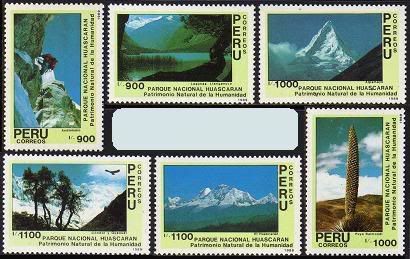
Situated in the Cordillera Blanca, the world's highest tropical mountain range, Mount Huascarán rises to 6,768 m above sea-level. The deep ravines watered by numerous torrents, the glacial lakes and the variety of the vegetation make it a site of spectacular beauty. It is the home of such species as the spectacled bear and the Andean condor.

Israel – Biblical tells at Megiddo, Hazor and Beer Sheba
After a long week away for spring holiday I was back and received a lot of stamps and postcards on my favourite topic, UNESCO World Heritage stamps. I am so happy. Bellow is the 2005 Israeli stamp set on Biblical Telss, Hazor and Beer Sheba. It seems to me that the Israel stamps always have tabs.
Tells, or pre-historic settlement mounds, are characteristic of the flatter lands of the eastern Mediterranean, particularly Lebanon, Syria, Israel and Eastern Turkey. Of more than 200 tells in Israel, Megiddo, Hazor and Beer Sheba are representative of tells that contain substantial remains of cities with biblical connections. The three tells also present some of the best examples in the Levant of elaborate Iron Age, underground water collecting systems, created to serve dense urban communities. Their traces of construction over the millennia reflect the existence of centralized authority, prosperous agricultural activity and the control of important trade routes.

Tells, or pre-historic settlement mounds, are characteristic of the flatter lands of the eastern Mediterranean, particularly Lebanon, Syria, Israel and Eastern Turkey. Of more than 200 tells in Israel, Megiddo, Hazor and Beer Sheba are representative of tells that contain substantial remains of cities with biblical connections. The three tells also present some of the best examples in the Levant of elaborate Iron Age, underground water collecting systems, created to serve dense urban communities. Their traces of construction over the millennia reflect the existence of centralized authority, prosperous agricultural activity and the control of important trade routes.

Costa Rica – Cocos Island National Park
This stamp sheet was issued in 2006. I bought it in ebay.
Cocos Island National Park, located 550 km off the Pacific Coast of Costa Rica, is the only island in the tropical eastern Pacific with a humid tropical forest. Its position as the first point of contact with the northern equatorial counter current and the myriad of interactions between the island and the surrounding marine ecosystem make the area an ideal laboratory for the study of biological processes. The underwater world of the national park has become famous due to the attraction it has for divers who rate it as one of the best places in the world to view large pelagic species such as sharks, rays, tuna and dolphins.
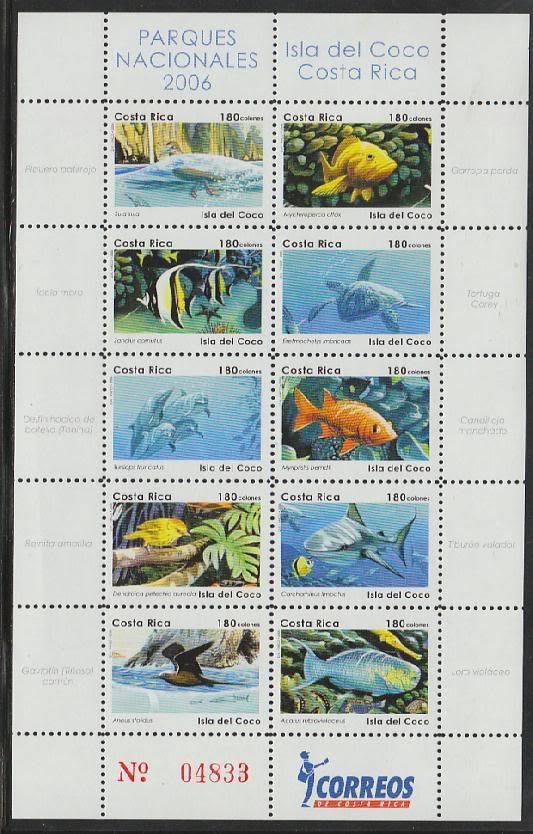
Cocos Island National Park, located 550 km off the Pacific Coast of Costa Rica, is the only island in the tropical eastern Pacific with a humid tropical forest. Its position as the first point of contact with the northern equatorial counter current and the myriad of interactions between the island and the surrounding marine ecosystem make the area an ideal laboratory for the study of biological processes. The underwater world of the national park has become famous due to the attraction it has for divers who rate it as one of the best places in the world to view large pelagic species such as sharks, rays, tuna and dolphins.

Pre-hispanic City of Chichen Itza
This is two 2007 SS with different shades from Mexico on Chichen Itza.
This site is one of the most impressive testimonies to the Mayan-Toltec civilization of the Yucatan (10th to 15th centuries). It contains some of the most outstanding examples of Central American architecture, combining Mayan construction techniques and Toltec sculpted decoration.
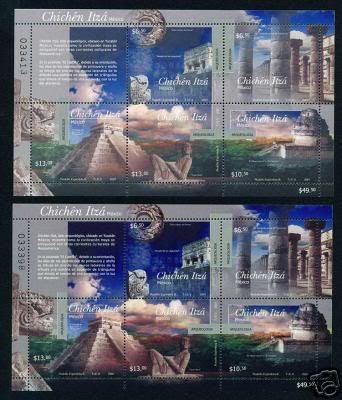
This site is one of the most impressive testimonies to the Mayan-Toltec civilization of the Yucatan (10th to 15th centuries). It contains some of the most outstanding examples of Central American architecture, combining Mayan construction techniques and Toltec sculpted decoration.

Friday, March 21, 2008
2007 Uzbekistan Samarkan MSs
I am so happy now because I just got 2007 Uzbekistan MSs on Samarkan. My friend, Camila helped me to get them. Thank Camila and her mother so much.
The historic town of Samarkand is a crossroads and melting pot of cultures. Founded in the 7th century bc as ancient Afrasiab, Samarkand had its most significant development in the Timurid period from the 14th to the 15th centuries. The major monuments include the Registan Mosque and madrasahs, Bibi-Khanum Mosque, the Shakhi-Zinda compound and the Gur-Emir ensemble, as well as Ulugh-Beg’s Observatory.
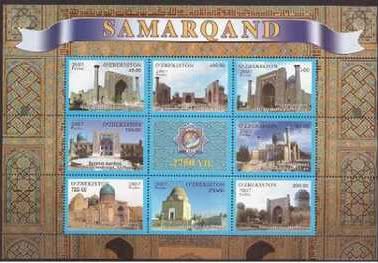
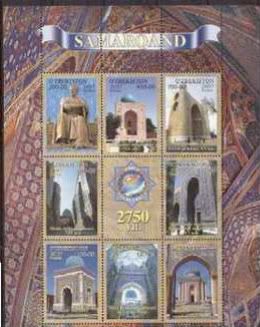
The historic town of Samarkand is a crossroads and melting pot of cultures. Founded in the 7th century bc as ancient Afrasiab, Samarkand had its most significant development in the Timurid period from the 14th to the 15th centuries. The major monuments include the Registan Mosque and madrasahs, Bibi-Khanum Mosque, the Shakhi-Zinda compound and the Gur-Emir ensemble, as well as Ulugh-Beg’s Observatory.


2004 Bosnia -Herzegovina The Old Bridge in Mostar
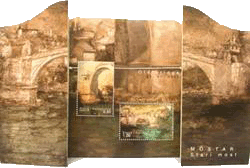
I bought this very beautiful presentation pack of the Old Bridge in Mostar in Delcampe.
The historic town of Mostar, spanning a deep valley of the Neretva River, developed in the 15th and 16th century as an Ottoman frontier town and during the Austro-Hungarian period in the 19th and 20th centuries. Mostar has long been known for its old Turkish houses and Old Bridge, Stari Most, after which it is named. In the 1990 conflict, however, most of the historic town and the Old Bridge, designed by the renowned architect, Sinan, were destroyed. The Old Bridge was recently rebuilt and many of the edifices in the Old Town have been restored or rebuilt with the contribution of an international scientific committee established by UNESCO. The Old Bridge area, with its pre-Ottoman, eastern Ottoman, Mediterranean and western European architectural features is an outstanding example of a multicultural urban settlement. The reconstructed Old Bridge and Old City of Mostar is a symbol of reconciliation, international cooperation and of the coexistence of diverse cultural, ethnic and religious communities.
Subscribe to:
Posts (Atom)
